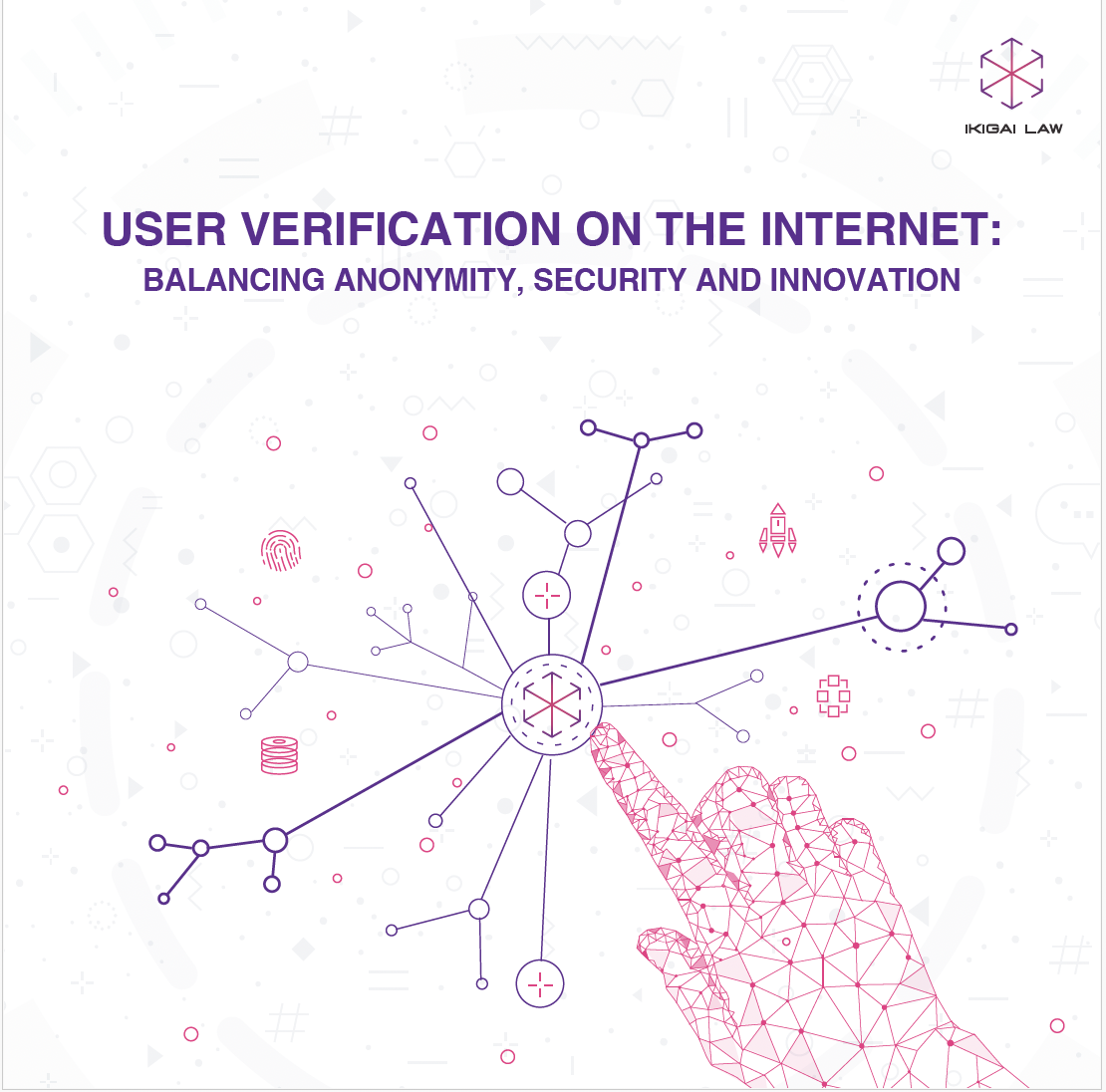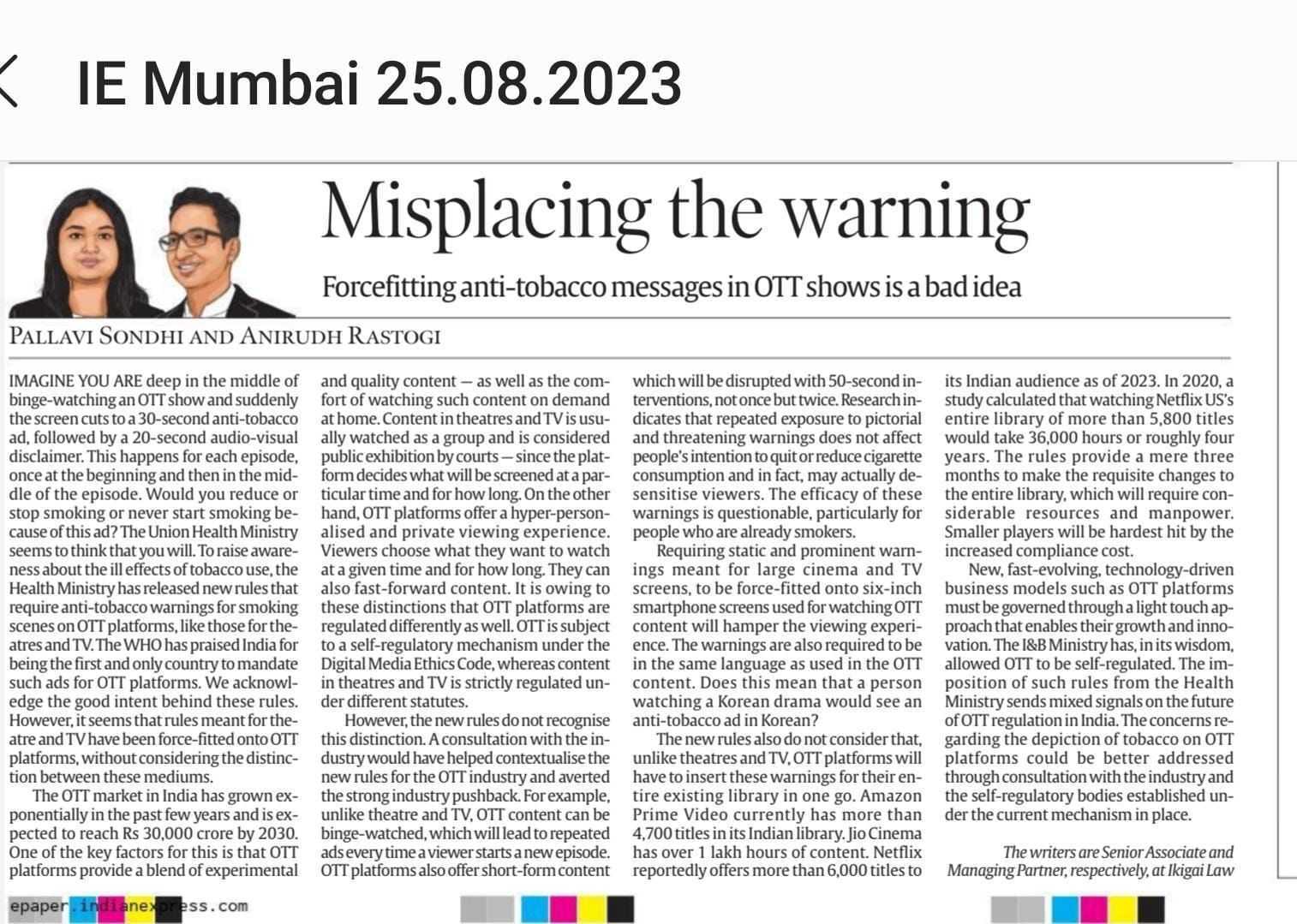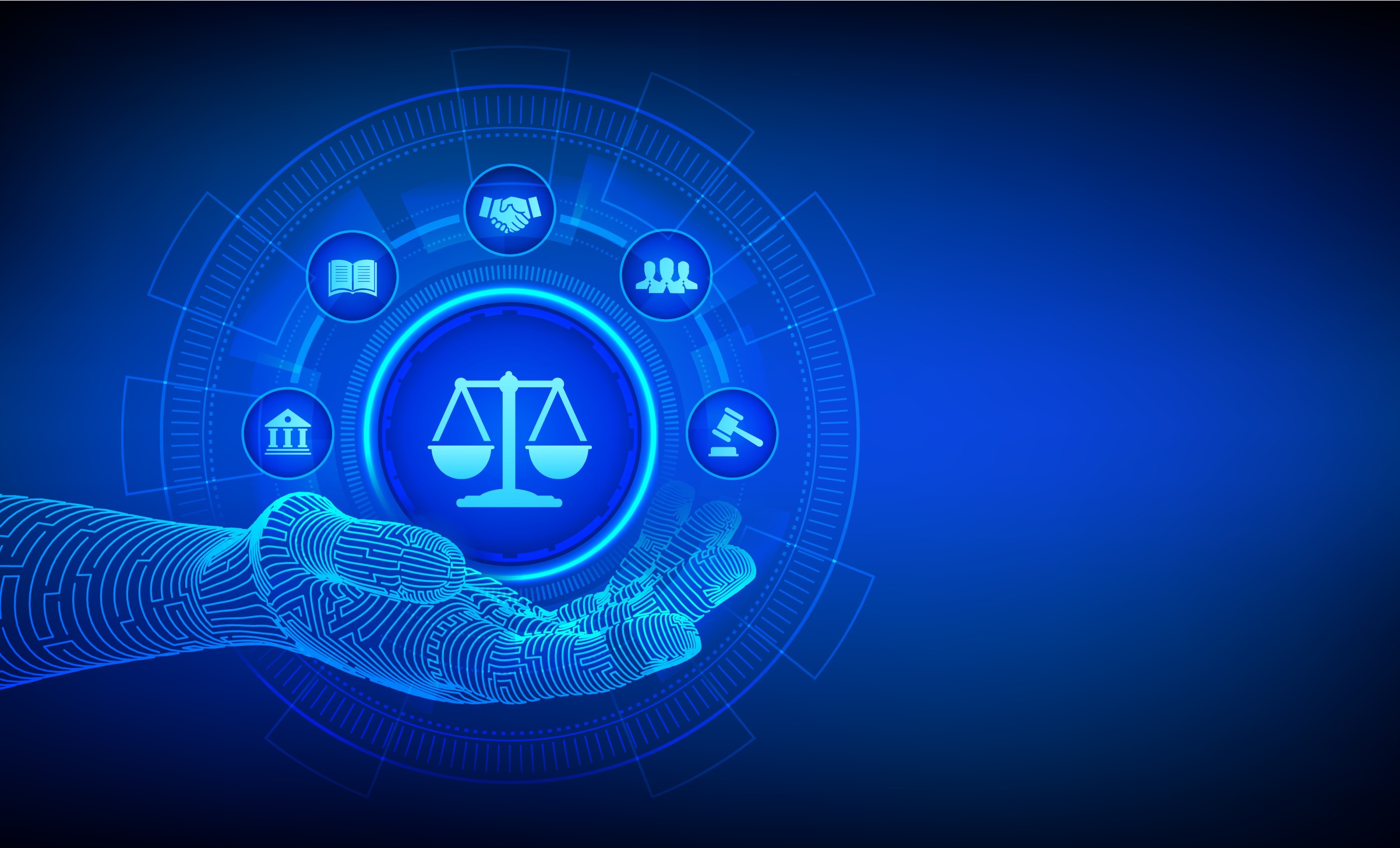1. Preliminary
Public stakeholder consultations allow non-governmental bodies like academic institutions, policy organisations, private companies and civil society organisations to participate in the government’s decision-making process. This makes the process comprehensive, transparent and inclusive. Conducting such stakeholder consultations sits at core of the Telecom Regulatory Authority of India’s (“TRAI”) responsibilities. Given the importance of these consultations, Vihang Jumle, associate at Ikigai Law, undertook a project to study instances where stakeholders were able to significantly influence TRAI’s views on issues relating to internet services through the public consultation process.
This blog studies the Draft National Telecom Policy 2018 and discusses issues on which the TRAI’s views changed over the course of the consultation process. For an explanation on the methodology and the scope of this project, click here. To read our previous blog that maps consultation papers where the TRAI’s position did not change pursuant to the consultation process, click here.
2. What changed and where?
2.1 Draft National Telecom Policy 2018 (“NTP”)
The consultation paper on “Inputs for Formulation of NTP – 2018” (“Consultation paper”) was released in January 2018. The consultation paper presented a draft version of the NTP that built on national telecom policies released in 1994, 1999, 2004 and 2012. The recommendation paper, which contained the final draft of the NTP 2018 (“Recommendations”) was released in February 2018.
Following are issues from the NTP, on which the TRAI changed its positions in the final draft as compared to the initial draft, presumably as a consequence of the consultation process.
2.1.1. Name of the policy
The NTP has been referred to using different names in the past. The 1994 version was called the ‘National Telecom Policy’, the 1999 version was called the ‘New Telecom Policy’, the 2004 version was called the ‘Broadband Policy’ and the 2012 version was called the ‘National Telecom Policy’. Though the Consultation Paper refers to the policy as ‘National Telecom Policy 2018’, the Recommendations suggested the name of the policy be changed to the ‘Information and Communication Technology Policy 2018’.
The Recommendations stated that the suggestion to re-name the policy was made keeping in mind the comparatively broader scope of the policy and its increased focus on emerging technologies. The Recommendations also stated that similar suggestions were made by different stakeholders during in-person stakeholder consultations.
2.1.2. Public Wi-Fi hotspots
On public Wi-Fi hotspots, the Consultation Paper stated that 10 million public Wi-Fi hotspots should be developed by devising enabling provisions for their sustainable development.
The Recommendations stated that 2 millionpublic WLAN (including Wi-Fi) hotspots should be developed by 2020 and 5 million by 2022 by devising enabling provisions for their sustainable development, their interoperability and sharing.
Thus, TRAI changed its target from 10 million public Wi-Fi hotspots as stated in the Consultation Paper to 2 million public WLAN (including Wi-Fi) hotspots by 2020 and 5 million by 2022 in its Recommendations, and also discussed the importance of the interoperability of such hotspots.
Stakeholder responses on the development of public Wi-Fi hotspots indicate that this change was not triggered by stakeholder views on the issue. These responses can be seen below:
2.1.2.1. Cellular Operators Association of India (“COAI”) suggested that a proper mechanism to count the number of Wi-Fi hotspots should be put in place.
2.1.2.2. Telecom Equipment and Services Promotion Council suggested that strong internet connectivity and Wi-Fi facilities across the country were necessary to propel ‘Digital India’ and ‘Smart Cities’.
2.1.2.3. CISCO Systems India suggested that the NTP should outline any applicable licensing conditions for providing internet services through the smart city network. The NTP should also lay out any conditions on providing logically separate secure infrastructure for all the different entities using the smart city network.
2.1.2.4. Broadband India Forum (“BIF”) suggested that the number of Wi-Fi hotspots to be set up should be changed to 75 million from 10 million. It suggested that the current situation of the number of public Wi-Fi hotspots in the country is not encouraging. BIF said that the revision to 75 million from 10 million was to enable India to provide 1 Wi-Fi hotspot for every 20 people and hence meet the global average by 2022 or 2023.
Thus, it appears that stakeholders did not play a substantial role in influencing the TRAI’s thinking on the number of public Wi-Fi hotspots that should be set up in India under the NTP.
2.1.3. Access to internet of things (“IoT”) devices
The Consultation Paper stated that a licensing and regulatory framework for IoT/machine to machine (“M2M”) sensors/devices must be prescribed to enable connectivity for 10 billion IoT devices.
The Recommendations stated that a simplified and enabling licensing framework would be necessary to enable connectivity for 1 billion IoT devices by 2020 and 5 billion by 2022.
Thus, TRAI changed its target of enabling access to 10 billion IoT devices to a staggered and time-bound plan of enabling access to 1 billion IoT devices by 2020 and 5 billion by 2022. It also stressed the need for a simple enabling licensing framework for IoT devices in its Recommendations, unlike the Consultation Paper which only stated that a licensing framework would be necessary for the proliferation of the IoT ecosystem.
Relevant stakeholder responses on access to IoT devices indicate that the change in TRAI’s goals for access to IoT devices was not triggered by stakeholder views on the issue. However, certain responses indicate that the emphasis on the need for a simplified and enabling licensing framework for IoT devices was influenced by stakeholder views on the issue. These responses can be seen below:
2.1.3.1. The App Association
A. The NTP should focus on providing wireline and wireless broadband capacity to propel the growth of IoT and M2M industries, however, it should not regulate or introduce licensing for the “network edge” since it may deter innovation.
B. India should not create a licensing regime for firms that provide IoT/M2M products or services since it would create a new layer of companies responsible for licensing on top of the existing IoT/M2M product companies and may hinder the entry of new innovative players. A telecom style licensing regime should not be applied to the IoT/M2M industry since it may slow down the growth of the nascent industry.
C. The App Association represents over 5000 app companies and IT firms across the mobile industry. It advocates for an environment that supports innovation and provides necessary resources to help its members grow their businesses. A licensing framework, as proposed within the NTP, will make it difficult for members of The App Association to sell their products. It will further disincentivise new players from developing more innovative products and slow down the growth of the industry. Observing this downside of the policy, The App Association may have opposed the introduction of licensing in the industry.
2.1.3.2. The COAI
A. There is a need for a “conducive licensing framework” to facilitate the development of the IoT/M2M industry. Rules laid under the unified licensing regime and the proposed convergent framework should be applicable to all players in the digital ecosystem.
B. The COAI is an industry association of telecommunications services providers in India. The telecommunications indsutry in India is regulated whereas the IoT/M2M or over-the-top (“OTT”) industry is not despite providing similar services. The telecommunications industry argues that the absence of regulation for the OTT industry creates an unfair playing field by putting the regulated telecommunications industry at a competitive disadvantage. This may have been the reason behind the COAI advocating the introduction of a licensing framework for the IoT/M2M industry. Further, regulating an industry is necessary to safeguard users’ rights and build a checks and balances mechanism to prevent potential industrial downturns. Regulating an industry, however, runs the risk of stifling innovation. This may have been the motivation behind the COAI advocating a “conducive licensing framework” as against a stringent licensing framework.
2.1.3.3. UNLIMIT – A Reliance Group Company (“Unlimit”)
A. The NTP should be approached with a “different policy mindset” to be able to reach the target of 10 billion IoT/M2M devices.
B. The NTP should focus “quick business enablement” and reducing the turnaround time of bureaucratic procedures.
C. The Preamble should be modified to include: “NTP 2018 recognizes the importance of M2M services in achieving true digitization of the society. Projects such as Smart City cannot be realized without the active deployment of M2M services. The subscription of these services is set to cross that of the human subscription and therefore, it is imperative that these services be provided the requisite focus in this NTP”.
D. The Mission should be modified to include: “To create an environment that is conducive for exploitation of the networks for deployment and proliferation of M2M services”.
E. Unlimit provides IoT products and services. By proposing the NTP to focus on “quick business enablement” and reducing the turnaround time of bureaucratic procedures, Unlimit may have implicitly advocated against the regulation of the IoT/M2M industry since it is only then that new businesses can be quickly introduced. Minimal regulation will ease the entry of IoT and M2M businesses and therefore it makes sense for Unlimit to take this stance.
2.1.3.4. DigiAnalysys Media
A. The target set within the NTP for IoT/M2M is not easy to achieve.
B. DigiAnalysys Media is a digital magazine that covers ICT developments in India and abroad. DigiAnalysys Media’s comment to the NTP may have been its opinion. No analysis was presented around how the digital magazine reached its conclusion.
2.1.3.5. Accessnow
A. The licensing of cloud computing and IoT service providers may not be enough to meet the set objectives for IoT/M2M devices in the NTP.
B. Though the regulation of IoT/M2M devices may be necessary to protect the rights of users, licensing may slow down the development of the cloud computing and IoT sector in India.
C. The licensing of general-purpose services my lie outside the regulatory scope of DoT and TRAI.
D. Accessnow is a non-for-profit that works to protect the rights of users on the internet. It said that introducing a licensing framework in the IoT/M2M industry will impede the policy from meeting its objective. Accessnow said that though regulations are necessary to protect the rights of users, licensing may slowdown the development of cloud and IoT sector in India.
2.1.3.6. US-India Strategic Partnership Forum (“USISPF”)
A. Regulatory and licensing barriers to the deployment of IoT/M2M services should be removed.
B. USISPF is a not-for-profit organisation that works to strengthen India-US bilateral ties and represents the interests of US firms that operate in India. It is likely that American IoT firms who are members of the USISPF may have advocated against the introduction of licensing in the IoT industry through USISPF. Sensing the nascent stage of IoT industry in India, it is also possible that the USISPF may have advocated against such licensing within the IoT industry to ease the entry of IoT based US firms in the future.
2.1.3.7. CISCO Systems India
A. The NTP should include a strategy to “enable a policy framework for network scaling that helps in connection of billions of new devices” to meet the objective set for IoT/M2M devices.
B. CISCO Systems is a manufacturer of networking hardware, telecommunication equipment and other communications technology equipment. Cisco Systems may have advocated for a policy framework to further scale network infrastructure in India since it will increase the demand of communication equipment, thereby helping Cisco Systems grow sales. Cisco Systems has also ventured into manufacturing IoT equipment and therefore a policy framework enabling the growth of IoT networks in India is likely to further boost Cisco Systems’ IoT business segment.
2.1.3.8. The Associated Chambers of Commerce in India (“ASSOCHAM”)
A. The NTP should focus on light touch regulation that would encourage innovation within the industry as against heavy regulation that will restrict the entry of new players and hinder innovation.
B. The NTP should remove regulatory and licensing barriers to the deployment of IoT/M2M services.
C. An ASSOCHAM – Ernst & Young report had estimated that the IoT market in India could reach 2 billion connections by 2022. Such estimates may convey that ASSOCHAM is optimistic about the growth of the IoT industry in India. It may have hence advocated for only light touch regulations and removing licensing barriers for the IoT industry.
2.1.3.9. BIF
A. The statement “By prescribing licensing and regulatory framework for IoT/M2M service providers” should be modified to “By removing all regulatory and licensing barriers for the deployment of IoT/M2M services”.
B. BIF is a think tank and an industry consortium that represents the telecommunications and broadband service providers.
Thus, it appears that stakeholders did not play a substantial role in influencing the TRAI’s thinking on the number of IoT devices that should be accessible in India. However, BIF, ASSOCHAM, App Association, COAI, UNLIMIT and the USISPF did shape the TRAI’s thinking on the nature of the licensing and regulatory framework for IoT devices.
2.1.4. Withdrawal of the Telecommunications Standards Development Society, India’s (“TSDSI”) responsibilities
The Consultation Paper states that the Telecommunication Engineering Centre (“TEC”)and TSDSIshould be responsible for the development and enforcement of standards for telecom products and services.
The Recommendations state that the TEC should be responsible for such matters, with no reference to the TSDSI.
Stakeholder responses indicate that TRAI’s views on the role of the TSDSI were influenced by stakeholder views on the matter:
2.1.4.1. The COAI
A. Enforcement of standards falls beyond the responsibilities of TEC and TSDSI and hence the two bodies should only concern themselves with development of standards and not their enforcement.
2.1.4.2. Telecom Equipment and Services Promotion Council
A. TSDSI should not be the authority responsible for enforcing standards.
B. TEC should be governing body responsible for notifying ‘National Standards’ and enforcing them, whereas the TSDSI can continue to work on ‘International Standards’.
C. The two bodies can also assist the Bureau of Indian Standards since it lacks expertise in telecommunications.
2.1.4.3. ASSOCHAM
A. The TEC should be strengthened.
The TEC is a technical body that represents the interests of the department of telecommunications, government of India. TSDSI is a not-for-profit, autonomous, membership based, standards development organisation for telecommunications and ICT products and services in India. Neither the TEC nor the TSDSI are bodies responsible for the enforcement of technical standards in India. These two bodies are only responsible for development of technical standards (especially telecommunications industry standards) in India. Elevating the TEC and TSDSI to the status of enforcement authorities would have created a conflict between the responsibilities of the two bodies and the Bureau of Indian Standards. While TEC is an organisation controlled by the government of India, the TSDSI is an autonomous body that comprises of telecom operators, manufactures, R&D organisations and stakeholders of the academia. COAI, the Telecom Equipment and Services Promotion Council may have pushed for the withdrawal of the TSDSI as the enforcement body because TSDSI comprises of members who are not part of the Indian government and hence its governance may be biased towards the interests of its members.
(Authored by Vihang Jumle, Associate, with inputs from Tuhina Joshi, Policy Associate at Ikigai Law.)










